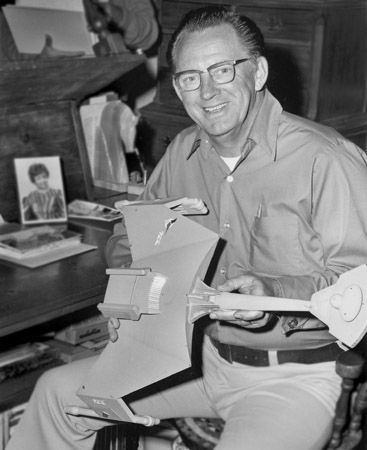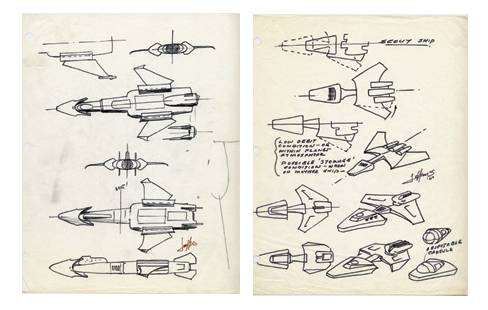This is the first of a series of posts tracing the storied path of the Leif Ericson, a spaceship designed in 1968 whose afterlife has carried it through a number of incarnations in different media formats – most notably, plastic.
Origins
Reflecting the many odd waypoints and junctions through which its journey would eventually take it, the Leif Ericson had more than one starting point: as with a quantum particle, its emergence can be fixed in relation to multiple and not always commensurate frames of reference, and our choice of perspective changes the very nature of the object we describe. One the one hand, we can see it as the creation of a single, inspired author; on the other, the product of a set of industrial forces.
In the first version, the Ericson was born in 1968 in the sketchbooks of Walter “Matt” Jefferies (1921-2003), production artist on the original Star Trek series. [1] Part of a team of designers that included propmaker Wah Ming Chang, costumer William Ware Thiess, and makeup artist Fred Philips, Jefferies—whose background in aviation and mechanical illustration was ideally suited to visualizing futuristic technologies in blueprintable, buildable forms—supplied Trek with its most familiar and recognizable features. These included the exterior of the U.S.S. Enterprise, with its saucer-shaped command module joined to a cigar-shaped engineering section from which two narrow, cylindrical warp nacelles jetted backwards: a configuration of geometrical solids whose basic arrangement has endured throughout fifty years of resculpting and streamlining in one movie, TV series, and videogame after another. Jefferies also designed the Enterprise’s circular bridge, its crew’s quarters, and the transporter room. Built as standing sets and used repeatedly across the seventy-nine episodes of the original series, these fixtures of a future history quickly became as familiar to audiences as the other, smaller details contributed by Jefferies: Starfleet’s golden arrowhead insignia; the instrumental triumvirate of communicator, tricorder, and phaser. But for the model-building fans who play such an important role in this story, Jefferies’s most important creations were his ships: not just the Enterprise, but the submarine-shaped Botany Bay commanded by Khan in “Space Seed”; the turreted, whirligig space station in “The Trouble with Tribbles”; the Klingon’s manta-ray-like battle cruiser in “The Enterprise Incident”; the boxy, three-windowed shuttlecraft in “Galileo 7.”
The Leif Ericson originated as another of Jefferies’s fictional spacecraft, but not one that ever appeared on Trek—or at least not for many years. In 1968, Jefferies sketched a pointed, rocketlike ship along with a smaller vessel whose delta wings and bulbous front section vaguely resembled a baby bird. Designed as a pair—the second craft would ride within the larger vehicle, inside a hangar covered by two hinged doors—the Galactic Cruiser Leif Ericson, together with its “mini scout ship,” were to be the first release in a series intended not for TV but toys: a line of model kits put out by a company called AMT.
To be continued …


